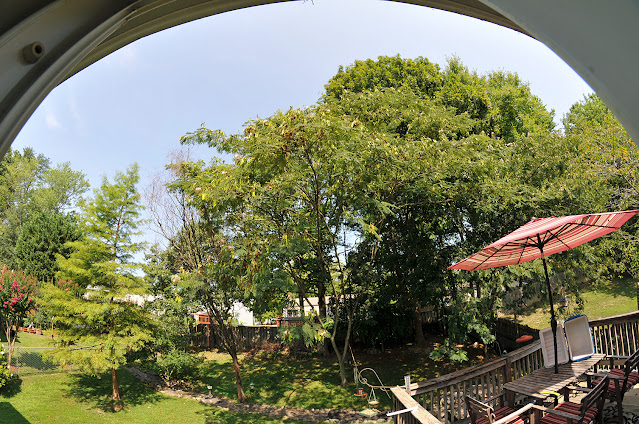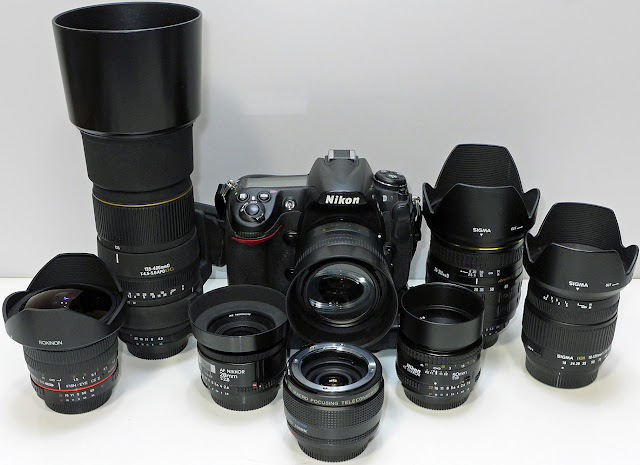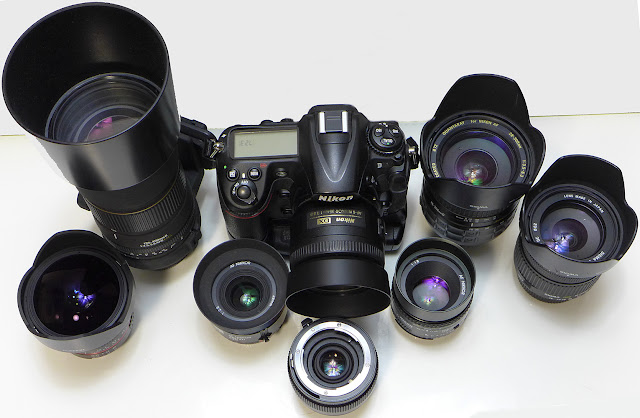August 13, 2021
#432
Gentle reader,
Although I am nearing 65, (well, if one counts all the leap years' extra days, I have passed that birthday) I could not afford a "real camera", i.e., a 35mm SLR until I was 38 in 1994.
I knew nothing about fancy cameras, only having owned a JCPenney 110, but the Olympus designers in Japan had me in mind when they designed their OM-10 SLR. If one pressed the shutter button, the camera turned itself on, took the photo and shut itself off. But I learned. A lot. From many sources.
After getting my feet wet, a year or so later, I came across an old Yashica J 35mm rangefinder camera for five bucks at a church bazaar. My new father-in-law showed me how to focus with it. With that I decided to collect cameras. To my utter surprise and delight, people started giving me old cameras!
But, I am getting off topic. I do that sometimes, regular readers are accustomed to that. Some even seem to enjoy it.
The lens came with this nice padded fabric bag to keep it protected. It's a good thing since there is NO room in the bag for another lens.
Since that is a Ritz Cameras' Quantaray brand bag, I guess it is vintage and a collector's item. That sucker weighs over sixteen pounds! Glass is heavy.
I have long been interested in getting a Nikon specific 8mm fisheye lens, and dabbled with some other types and focal lengths.
This Sigma-made Spiratone T-mount 12mm lens is nice, but
S-L-O-W at f8.0, and only 12mm.
It's much older predecessor is this Spiratone auxiliary lens which does provide a full circle image, but not very good ones.
What bothered me, and probably many others, is the vast majority of inexpensive 8mm fisheye lenses are manual focus and aside from having the right mount, the camera "sees" it as a fully manual lens and the shooter has to use M mode with them.
Then, one day looking on eBay, I spied a Rokinon 8mm f3.5 fisheye lens with CONTACTS on it to communicate with the camera bodies computer. Now we are talking!
I had been given a $75 Amazon gift card, but these new on the site are $219.00. Since I'm on a fixed budget, I needed it to cost less.
Fortunately, they had "Refreshed" lenses (one left!) for considerably less.
My first Nikon DSLR, a D70S, was "Factory Recertified", so I knew what I was getting into.
Manufacturers are putting their reputation on the line by taking returns and correcting what is wrong and then reselling the item again.
The lens comes with the full factory warranty and I could find no signs of any usage whatsoever.
Plus, with the contacts, I can leave the camera in full auto, it will tell me whether the lens is focused, the camera works as if it was an autofocus lens. Here are some practice shots I made with it, in auto mode.

This first shot, in our living room, was without flash, just available light. One can see the fan blades are blurry.
I changed the angle a bit and used the on-board flash. Fan blades are still. I was watching an Australian V8 Supercars race. Mini, our less-than-five-pounds Prague Ratter in the chair, is licking herself "where dogs are wont to do so." That's "Mom's" chair, so to protect it from the dogs, I put a blanket over it. If she's in the chair, so are they.
These two shots were made by me standing up where I am now sitting. With flash, above, and without below.
I then went to the kitchen and opened the window, placing the camera in the opened area.
This is angled to the left. Below is centered.
This is angled right, and below, angled upward.
By the way, the tallest tree is close to eighty feet. The one on the left (evergreen) is a Giant Sequoia, and it is at least forty feet tall.
Looking at the images full size on my 24 inch monitor, the edges are sharp. Now, would this compete with a Nikon fisheye? Not a chance. But for my planned use, it is perfect.
So, here it is, joining the family. You have previously seen my article about the 28, 35 and 50mm Nikon prime lenses, if not, here is a link:
Since I began collecting and using cameras, I have owned a total of 505. Many were rangefinders, but I had a lot of SLRs as well.
Anyway, as you can see, I had a LOT of lenses for that camera. Many were "YS" lenses. YS lenses were T-mount lenses which had automatic apertures. Prior to this camera, I had assembled a M42 camera kit with some of the same lenses.
The camera was a SEARS branded Ricoh SLR with a then blisteringly fast 1/2000th of a second shutter speed. It was called 2000 ES and came with a fast 55mm f1.4 lens. Anyway, I have found that as far as autofocus aftermarket lenses, Sigma models are the best. I initially had the "kit" 18-55mm Nikon G lens, but I was not impressed with it. That being said, what I have here are, left to right, the Rokinon 8mm, Sigma 135-400mm, Nikon 28mm f2.8, (on the camera) Nikon 35mm f1.8, (in front of the camera) a MF Vivitar 2X Macro focusing teleconverter, then a Nikon 50mm f1.8, behind that is a Quantaray (Sigma) 28-300mm and at the right a Sigma 18-135 mm lens.
Here is what's in the camera bag.
These three photos are from many months ago. Aside from the two batteries in the camera and bottom grip, I have a spare one, all Nikon brand.As much as I would like a Nikon flash, they are outside my budget range and the Opteka performs well.So, there you have it. I really could lose the (film) 28-300mm lens and possibly fit the 8mm in the bag, but it is a versatile lens. Plus, it's not like I haul the entire bag with me when I go out shooting.
If you do not yet have a fisheye lens, I heartily recommend the Rokinon brand, but look for the red ring around the lens and make sure it has the contacts so it will be as easy to use as an autofocus lens.I mentioned my 505 camera collection. Well, I did not own them all at the same time. I had around 200 at a time, the collection changed often. Above is all that is left. Almost all were given to me. This is how I displayed the cameras. I invented the method and call it: CameraLock.This Minolta 16mm camera belonged to Nancy's mother. I never knew her.This Yashica J was her dad's. The same model as the camera I found at the church bazaar. Next to is is a Pre-World-War-II Argus Model C camera. It still works perfectly, and I have shot with it.These two German beauties were given to me. The Rollei 35 by my brother, the Voigtlander Vitessa from a family friend. He carried it all over Korea during the war. Both still work fine and yield excellent photos.Cosina of Japan, bought the rights to the Voigtlander name and began producing a range of modern interpretations of vintage rangefinder cameras. Nancy bought me this one. It has a Soviet copy of a pre-war Zeiss Sonnar 50mm f2.0 lens on it. I have ONE roll of black and white film left in the freezer. It will go into this camera when the time is right.These two 8mm movie cameras were Nancy's parents. Somewhere, we have their 16mm camera as well.These two vintage Kodak roll film cameras were given to me by my sister. The folding one was in the original box.This tiny Japanese "spy" camera used tiny rolls of paper backed film and were barely able to be called cameras. Nancy gave it to me. Lastly, are the two cameras above. On the left is a camera Nancy's dad sent me from Puerto Rico, when he heard I was collecting them. It is a Busch Pressman 4" x 5" press camera. Take a look at the flash's handle. Look familiar? It's similar to what was used to make the Lightsabers in the original STAR WARS films. The one on the right is a Wrebbit Paper Pinhole camera. Yes, it is made of paper with black fabric for the bellows. Nancy bought the kit for me and I built it some years ago. I made some improvements to the 35mm film transport. It is modeled after the camera below, a Cyclographe. French, I believe. Pretty, isn't it? I will likely never shoot anything with that paper pinhole camera. Developing and printing film has gotten too costly.
Thank you SO much for taking the time to read my humble blog. It gives me great joy that so many people do.
Scott
August 13, 2021
#432














































No comments:
Post a Comment